Observation of Relationship between Child, Parent and Educator at Early Childhood Education Centre
VerifiedAdded on 2023/06/11
|8
|3254
|71
AI Summary
This observation aims to analyze the relationship between child, parent and educator at an early childhood education centre. The observation focuses on the child's behavior and interaction with the parent and educator. Strategies are suggested to improve the relationship between child and parent, and child and educator.
Contribute Materials
Your contribution can guide someone’s learning journey. Share your
documents today.
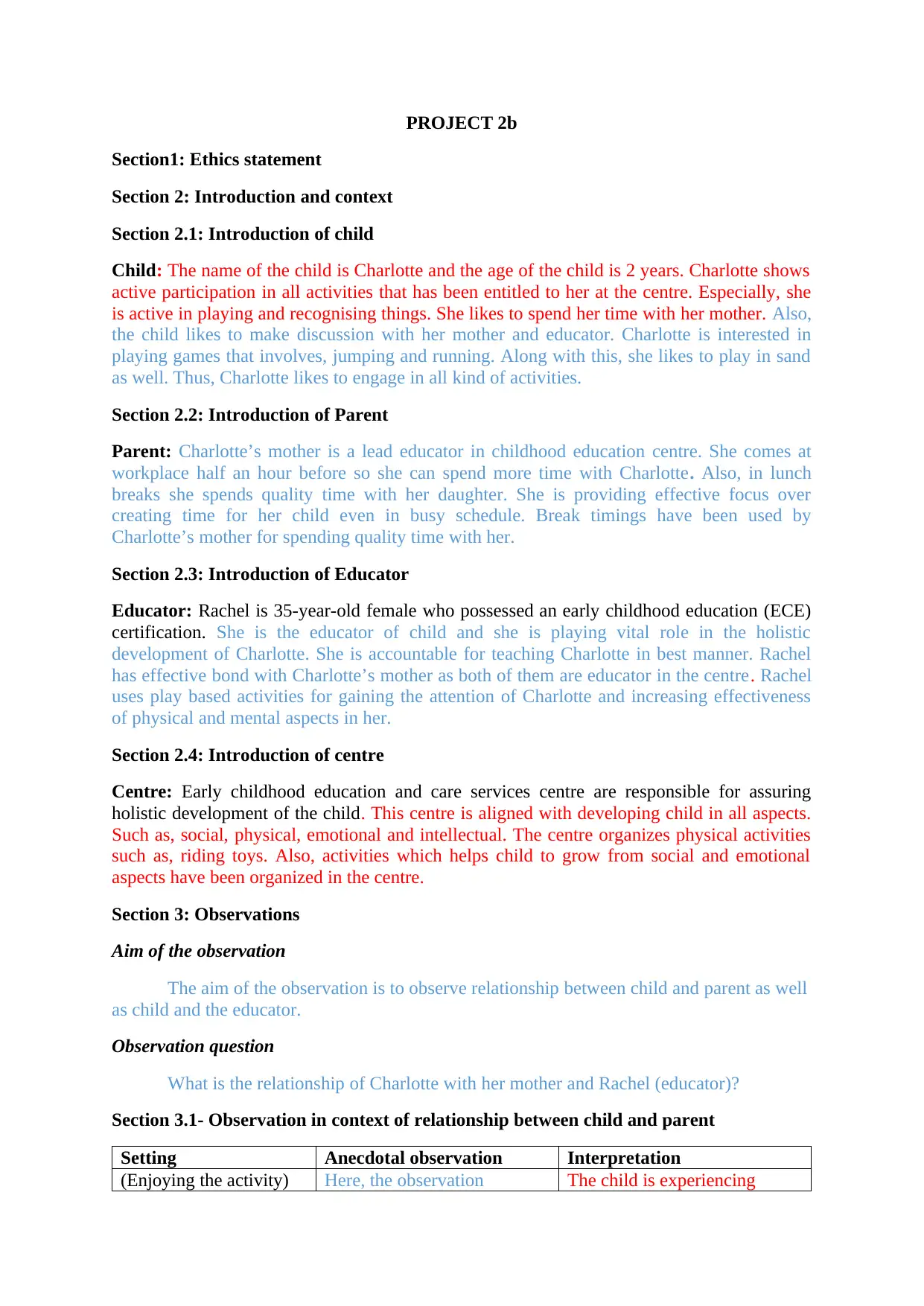
PROJECT 2b
Section1: Ethics statement
Section 2: Introduction and context
Section 2.1: Introduction of child
Child: The name of the child is Charlotte and the age of the child is 2 years. Charlotte shows
active participation in all activities that has been entitled to her at the centre. Especially, she
is active in playing and recognising things. She likes to spend her time with her mother. Also,
the child likes to make discussion with her mother and educator. Charlotte is interested in
playing games that involves, jumping and running. Along with this, she likes to play in sand
as well. Thus, Charlotte likes to engage in all kind of activities.
Section 2.2: Introduction of Parent
Parent: Charlotte’s mother is a lead educator in childhood education centre. She comes at
workplace half an hour before so she can spend more time with Charlotte. Also, in lunch
breaks she spends quality time with her daughter. She is providing effective focus over
creating time for her child even in busy schedule. Break timings have been used by
Charlotte’s mother for spending quality time with her.
Section 2.3: Introduction of Educator
Educator: Rachel is 35-year-old female who possessed an early childhood education (ECE)
certification. She is the educator of child and she is playing vital role in the holistic
development of Charlotte. She is accountable for teaching Charlotte in best manner. Rachel
has effective bond with Charlotte’s mother as both of them are educator in the centre. Rachel
uses play based activities for gaining the attention of Charlotte and increasing effectiveness
of physical and mental aspects in her.
Section 2.4: Introduction of centre
Centre: Early childhood education and care services centre are responsible for assuring
holistic development of the child. This centre is aligned with developing child in all aspects.
Such as, social, physical, emotional and intellectual. The centre organizes physical activities
such as, riding toys. Also, activities which helps child to grow from social and emotional
aspects have been organized in the centre.
Section 3: Observations
Aim of the observation
The aim of the observation is to observe relationship between child and parent as well
as child and the educator.
Observation question
What is the relationship of Charlotte with her mother and Rachel (educator)?
Section 3.1- Observation in context of relationship between child and parent
Setting Anecdotal observation Interpretation
(Enjoying the activity) Here, the observation The child is experiencing
Section1: Ethics statement
Section 2: Introduction and context
Section 2.1: Introduction of child
Child: The name of the child is Charlotte and the age of the child is 2 years. Charlotte shows
active participation in all activities that has been entitled to her at the centre. Especially, she
is active in playing and recognising things. She likes to spend her time with her mother. Also,
the child likes to make discussion with her mother and educator. Charlotte is interested in
playing games that involves, jumping and running. Along with this, she likes to play in sand
as well. Thus, Charlotte likes to engage in all kind of activities.
Section 2.2: Introduction of Parent
Parent: Charlotte’s mother is a lead educator in childhood education centre. She comes at
workplace half an hour before so she can spend more time with Charlotte. Also, in lunch
breaks she spends quality time with her daughter. She is providing effective focus over
creating time for her child even in busy schedule. Break timings have been used by
Charlotte’s mother for spending quality time with her.
Section 2.3: Introduction of Educator
Educator: Rachel is 35-year-old female who possessed an early childhood education (ECE)
certification. She is the educator of child and she is playing vital role in the holistic
development of Charlotte. She is accountable for teaching Charlotte in best manner. Rachel
has effective bond with Charlotte’s mother as both of them are educator in the centre. Rachel
uses play based activities for gaining the attention of Charlotte and increasing effectiveness
of physical and mental aspects in her.
Section 2.4: Introduction of centre
Centre: Early childhood education and care services centre are responsible for assuring
holistic development of the child. This centre is aligned with developing child in all aspects.
Such as, social, physical, emotional and intellectual. The centre organizes physical activities
such as, riding toys. Also, activities which helps child to grow from social and emotional
aspects have been organized in the centre.
Section 3: Observations
Aim of the observation
The aim of the observation is to observe relationship between child and parent as well
as child and the educator.
Observation question
What is the relationship of Charlotte with her mother and Rachel (educator)?
Section 3.1- Observation in context of relationship between child and parent
Setting Anecdotal observation Interpretation
(Enjoying the activity) Here, the observation The child is experiencing
Secure Best Marks with AI Grader
Need help grading? Try our AI Grader for instant feedback on your assignments.
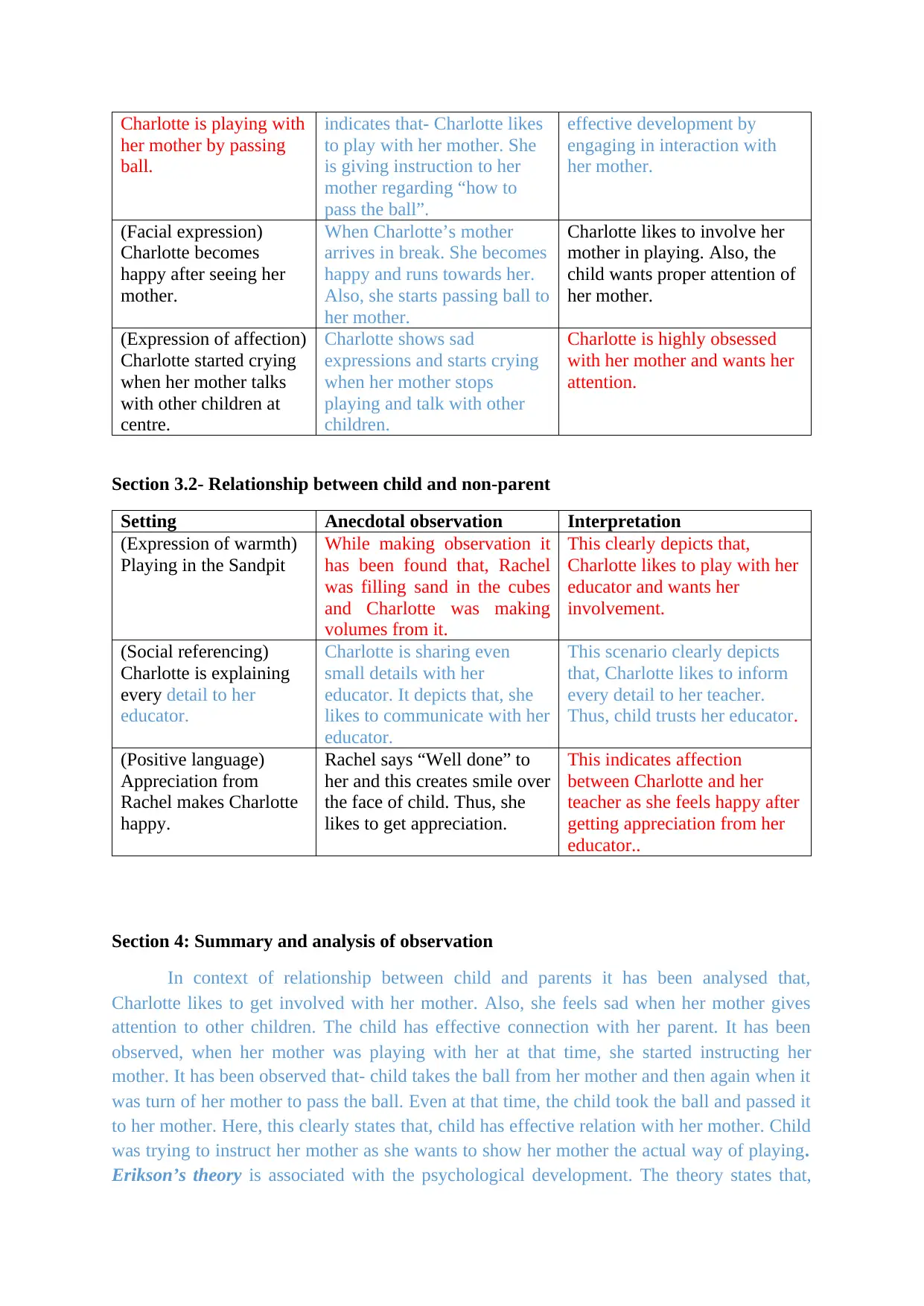
Charlotte is playing with
her mother by passing
ball.
indicates that- Charlotte likes
to play with her mother. She
is giving instruction to her
mother regarding “how to
pass the ball”.
effective development by
engaging in interaction with
her mother.
(Facial expression)
Charlotte becomes
happy after seeing her
mother.
When Charlotte’s mother
arrives in break. She becomes
happy and runs towards her.
Also, she starts passing ball to
her mother.
Charlotte likes to involve her
mother in playing. Also, the
child wants proper attention of
her mother.
(Expression of affection)
Charlotte started crying
when her mother talks
with other children at
centre.
Charlotte shows sad
expressions and starts crying
when her mother stops
playing and talk with other
children.
Charlotte is highly obsessed
with her mother and wants her
attention.
Section 3.2- Relationship between child and non-parent
Setting Anecdotal observation Interpretation
(Expression of warmth)
Playing in the Sandpit
While making observation it
has been found that, Rachel
was filling sand in the cubes
and Charlotte was making
volumes from it.
This clearly depicts that,
Charlotte likes to play with her
educator and wants her
involvement.
(Social referencing)
Charlotte is explaining
every detail to her
educator.
Charlotte is sharing even
small details with her
educator. It depicts that, she
likes to communicate with her
educator.
This scenario clearly depicts
that, Charlotte likes to inform
every detail to her teacher.
Thus, child trusts her educator.
(Positive language)
Appreciation from
Rachel makes Charlotte
happy.
Rachel says “Well done” to
her and this creates smile over
the face of child. Thus, she
likes to get appreciation.
This indicates affection
between Charlotte and her
teacher as she feels happy after
getting appreciation from her
educator..
Section 4: Summary and analysis of observation
In context of relationship between child and parents it has been analysed that,
Charlotte likes to get involved with her mother. Also, she feels sad when her mother gives
attention to other children. The child has effective connection with her parent. It has been
observed, when her mother was playing with her at that time, she started instructing her
mother. It has been observed that- child takes the ball from her mother and then again when it
was turn of her mother to pass the ball. Even at that time, the child took the ball and passed it
to her mother. Here, this clearly states that, child has effective relation with her mother. Child
was trying to instruct her mother as she wants to show her mother the actual way of playing.
Erikson’s theory is associated with the psychological development. The theory states that,
her mother by passing
ball.
indicates that- Charlotte likes
to play with her mother. She
is giving instruction to her
mother regarding “how to
pass the ball”.
effective development by
engaging in interaction with
her mother.
(Facial expression)
Charlotte becomes
happy after seeing her
mother.
When Charlotte’s mother
arrives in break. She becomes
happy and runs towards her.
Also, she starts passing ball to
her mother.
Charlotte likes to involve her
mother in playing. Also, the
child wants proper attention of
her mother.
(Expression of affection)
Charlotte started crying
when her mother talks
with other children at
centre.
Charlotte shows sad
expressions and starts crying
when her mother stops
playing and talk with other
children.
Charlotte is highly obsessed
with her mother and wants her
attention.
Section 3.2- Relationship between child and non-parent
Setting Anecdotal observation Interpretation
(Expression of warmth)
Playing in the Sandpit
While making observation it
has been found that, Rachel
was filling sand in the cubes
and Charlotte was making
volumes from it.
This clearly depicts that,
Charlotte likes to play with her
educator and wants her
involvement.
(Social referencing)
Charlotte is explaining
every detail to her
educator.
Charlotte is sharing even
small details with her
educator. It depicts that, she
likes to communicate with her
educator.
This scenario clearly depicts
that, Charlotte likes to inform
every detail to her teacher.
Thus, child trusts her educator.
(Positive language)
Appreciation from
Rachel makes Charlotte
happy.
Rachel says “Well done” to
her and this creates smile over
the face of child. Thus, she
likes to get appreciation.
This indicates affection
between Charlotte and her
teacher as she feels happy after
getting appreciation from her
educator..
Section 4: Summary and analysis of observation
In context of relationship between child and parents it has been analysed that,
Charlotte likes to get involved with her mother. Also, she feels sad when her mother gives
attention to other children. The child has effective connection with her parent. It has been
observed, when her mother was playing with her at that time, she started instructing her
mother. It has been observed that- child takes the ball from her mother and then again when it
was turn of her mother to pass the ball. Even at that time, the child took the ball and passed it
to her mother. Here, this clearly states that, child has effective relation with her mother. Child
was trying to instruct her mother as she wants to show her mother the actual way of playing.
Erikson’s theory is associated with the psychological development. The theory states that,
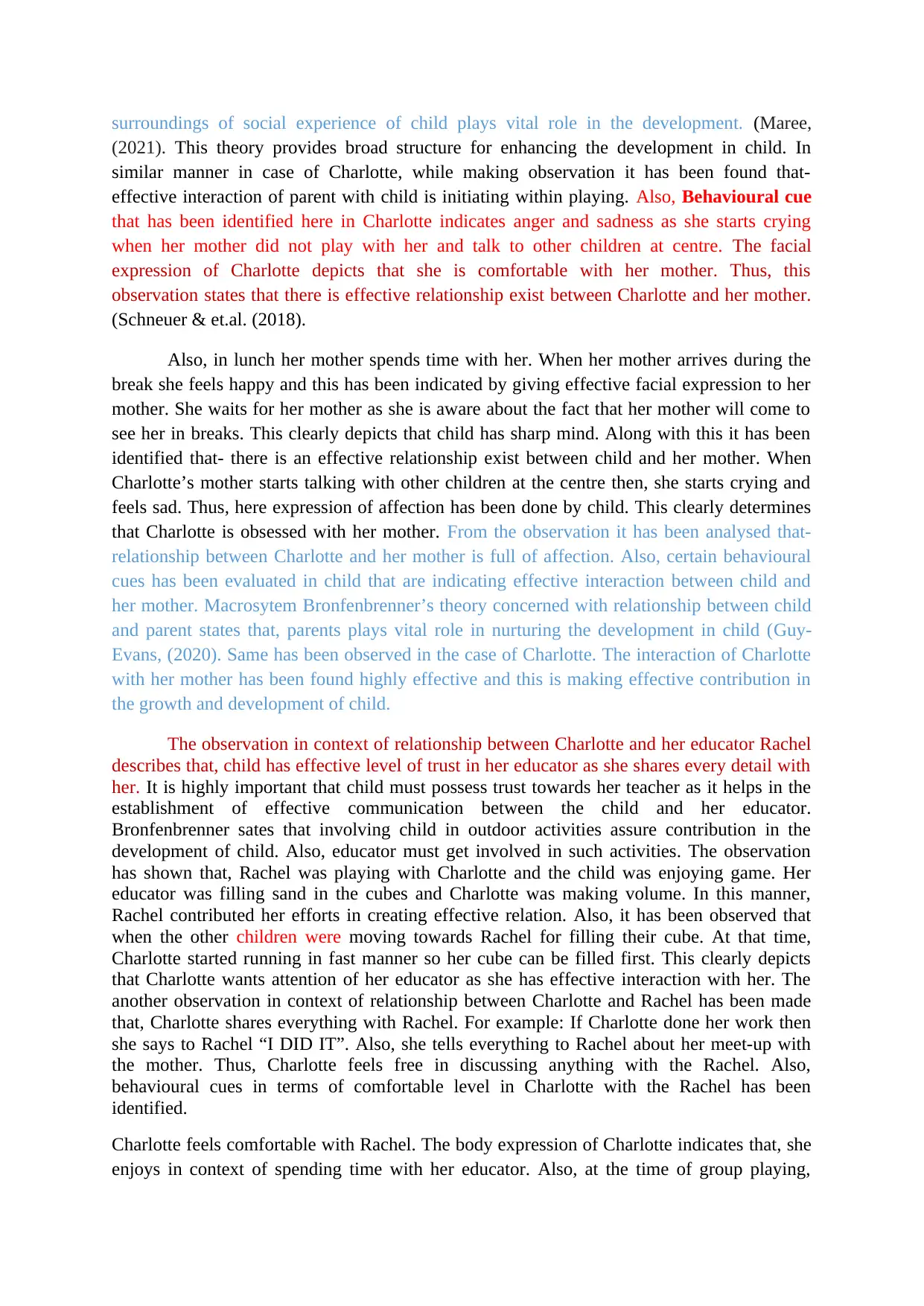
surroundings of social experience of child plays vital role in the development. (Maree,
(2021). This theory provides broad structure for enhancing the development in child. In
similar manner in case of Charlotte, while making observation it has been found that-
effective interaction of parent with child is initiating within playing. Also, Behavioural cue
that has been identified here in Charlotte indicates anger and sadness as she starts crying
when her mother did not play with her and talk to other children at centre. The facial
expression of Charlotte depicts that she is comfortable with her mother. Thus, this
observation states that there is effective relationship exist between Charlotte and her mother.
(Schneuer & et.al. (2018).
Also, in lunch her mother spends time with her. When her mother arrives during the
break she feels happy and this has been indicated by giving effective facial expression to her
mother. She waits for her mother as she is aware about the fact that her mother will come to
see her in breaks. This clearly depicts that child has sharp mind. Along with this it has been
identified that- there is an effective relationship exist between child and her mother. When
Charlotte’s mother starts talking with other children at the centre then, she starts crying and
feels sad. Thus, here expression of affection has been done by child. This clearly determines
that Charlotte is obsessed with her mother. From the observation it has been analysed that-
relationship between Charlotte and her mother is full of affection. Also, certain behavioural
cues has been evaluated in child that are indicating effective interaction between child and
her mother. Macrosytem Bronfenbrenner’s theory concerned with relationship between child
and parent states that, parents plays vital role in nurturing the development in child (Guy-
Evans, (2020). Same has been observed in the case of Charlotte. The interaction of Charlotte
with her mother has been found highly effective and this is making effective contribution in
the growth and development of child.
The observation in context of relationship between Charlotte and her educator Rachel
describes that, child has effective level of trust in her educator as she shares every detail with
her. It is highly important that child must possess trust towards her teacher as it helps in the
establishment of effective communication between the child and her educator.
Bronfenbrenner sates that involving child in outdoor activities assure contribution in the
development of child. Also, educator must get involved in such activities. The observation
has shown that, Rachel was playing with Charlotte and the child was enjoying game. Her
educator was filling sand in the cubes and Charlotte was making volume. In this manner,
Rachel contributed her efforts in creating effective relation. Also, it has been observed that
when the other children were moving towards Rachel for filling their cube. At that time,
Charlotte started running in fast manner so her cube can be filled first. This clearly depicts
that Charlotte wants attention of her educator as she has effective interaction with her. The
another observation in context of relationship between Charlotte and Rachel has been made
that, Charlotte shares everything with Rachel. For example: If Charlotte done her work then
she says to Rachel “I DID IT”. Also, she tells everything to Rachel about her meet-up with
the mother. Thus, Charlotte feels free in discussing anything with the Rachel. Also,
behavioural cues in terms of comfortable level in Charlotte with the Rachel has been
identified.
Charlotte feels comfortable with Rachel. The body expression of Charlotte indicates that, she
enjoys in context of spending time with her educator. Also, at the time of group playing,
(2021). This theory provides broad structure for enhancing the development in child. In
similar manner in case of Charlotte, while making observation it has been found that-
effective interaction of parent with child is initiating within playing. Also, Behavioural cue
that has been identified here in Charlotte indicates anger and sadness as she starts crying
when her mother did not play with her and talk to other children at centre. The facial
expression of Charlotte depicts that she is comfortable with her mother. Thus, this
observation states that there is effective relationship exist between Charlotte and her mother.
(Schneuer & et.al. (2018).
Also, in lunch her mother spends time with her. When her mother arrives during the
break she feels happy and this has been indicated by giving effective facial expression to her
mother. She waits for her mother as she is aware about the fact that her mother will come to
see her in breaks. This clearly depicts that child has sharp mind. Along with this it has been
identified that- there is an effective relationship exist between child and her mother. When
Charlotte’s mother starts talking with other children at the centre then, she starts crying and
feels sad. Thus, here expression of affection has been done by child. This clearly determines
that Charlotte is obsessed with her mother. From the observation it has been analysed that-
relationship between Charlotte and her mother is full of affection. Also, certain behavioural
cues has been evaluated in child that are indicating effective interaction between child and
her mother. Macrosytem Bronfenbrenner’s theory concerned with relationship between child
and parent states that, parents plays vital role in nurturing the development in child (Guy-
Evans, (2020). Same has been observed in the case of Charlotte. The interaction of Charlotte
with her mother has been found highly effective and this is making effective contribution in
the growth and development of child.
The observation in context of relationship between Charlotte and her educator Rachel
describes that, child has effective level of trust in her educator as she shares every detail with
her. It is highly important that child must possess trust towards her teacher as it helps in the
establishment of effective communication between the child and her educator.
Bronfenbrenner sates that involving child in outdoor activities assure contribution in the
development of child. Also, educator must get involved in such activities. The observation
has shown that, Rachel was playing with Charlotte and the child was enjoying game. Her
educator was filling sand in the cubes and Charlotte was making volume. In this manner,
Rachel contributed her efforts in creating effective relation. Also, it has been observed that
when the other children were moving towards Rachel for filling their cube. At that time,
Charlotte started running in fast manner so her cube can be filled first. This clearly depicts
that Charlotte wants attention of her educator as she has effective interaction with her. The
another observation in context of relationship between Charlotte and Rachel has been made
that, Charlotte shares everything with Rachel. For example: If Charlotte done her work then
she says to Rachel “I DID IT”. Also, she tells everything to Rachel about her meet-up with
the mother. Thus, Charlotte feels free in discussing anything with the Rachel. Also,
behavioural cues in terms of comfortable level in Charlotte with the Rachel has been
identified.
Charlotte feels comfortable with Rachel. The body expression of Charlotte indicates that, she
enjoys in context of spending time with her educator. Also, at the time of group playing,
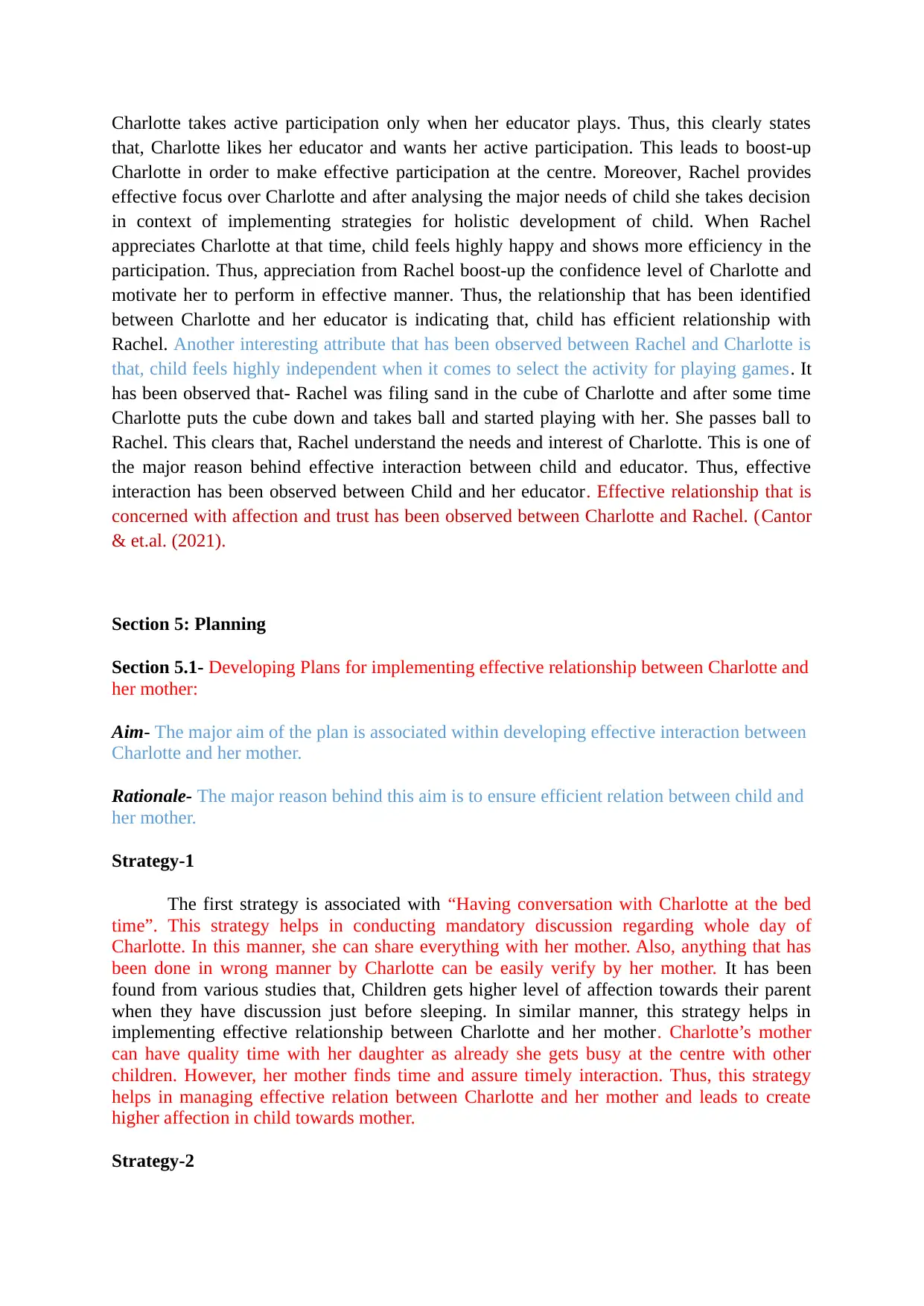
Charlotte takes active participation only when her educator plays. Thus, this clearly states
that, Charlotte likes her educator and wants her active participation. This leads to boost-up
Charlotte in order to make effective participation at the centre. Moreover, Rachel provides
effective focus over Charlotte and after analysing the major needs of child she takes decision
in context of implementing strategies for holistic development of child. When Rachel
appreciates Charlotte at that time, child feels highly happy and shows more efficiency in the
participation. Thus, appreciation from Rachel boost-up the confidence level of Charlotte and
motivate her to perform in effective manner. Thus, the relationship that has been identified
between Charlotte and her educator is indicating that, child has efficient relationship with
Rachel. Another interesting attribute that has been observed between Rachel and Charlotte is
that, child feels highly independent when it comes to select the activity for playing games. It
has been observed that- Rachel was filing sand in the cube of Charlotte and after some time
Charlotte puts the cube down and takes ball and started playing with her. She passes ball to
Rachel. This clears that, Rachel understand the needs and interest of Charlotte. This is one of
the major reason behind effective interaction between child and educator. Thus, effective
interaction has been observed between Child and her educator. Effective relationship that is
concerned with affection and trust has been observed between Charlotte and Rachel. (Cantor
& et.al. (2021).
Section 5: Planning
Section 5.1- Developing Plans for implementing effective relationship between Charlotte and
her mother:
Aim- The major aim of the plan is associated within developing effective interaction between
Charlotte and her mother.
Rationale- The major reason behind this aim is to ensure efficient relation between child and
her mother.
Strategy-1
The first strategy is associated with “Having conversation with Charlotte at the bed
time”. This strategy helps in conducting mandatory discussion regarding whole day of
Charlotte. In this manner, she can share everything with her mother. Also, anything that has
been done in wrong manner by Charlotte can be easily verify by her mother. It has been
found from various studies that, Children gets higher level of affection towards their parent
when they have discussion just before sleeping. In similar manner, this strategy helps in
implementing effective relationship between Charlotte and her mother. Charlotte’s mother
can have quality time with her daughter as already she gets busy at the centre with other
children. However, her mother finds time and assure timely interaction. Thus, this strategy
helps in managing effective relation between Charlotte and her mother and leads to create
higher affection in child towards mother.
Strategy-2
that, Charlotte likes her educator and wants her active participation. This leads to boost-up
Charlotte in order to make effective participation at the centre. Moreover, Rachel provides
effective focus over Charlotte and after analysing the major needs of child she takes decision
in context of implementing strategies for holistic development of child. When Rachel
appreciates Charlotte at that time, child feels highly happy and shows more efficiency in the
participation. Thus, appreciation from Rachel boost-up the confidence level of Charlotte and
motivate her to perform in effective manner. Thus, the relationship that has been identified
between Charlotte and her educator is indicating that, child has efficient relationship with
Rachel. Another interesting attribute that has been observed between Rachel and Charlotte is
that, child feels highly independent when it comes to select the activity for playing games. It
has been observed that- Rachel was filing sand in the cube of Charlotte and after some time
Charlotte puts the cube down and takes ball and started playing with her. She passes ball to
Rachel. This clears that, Rachel understand the needs and interest of Charlotte. This is one of
the major reason behind effective interaction between child and educator. Thus, effective
interaction has been observed between Child and her educator. Effective relationship that is
concerned with affection and trust has been observed between Charlotte and Rachel. (Cantor
& et.al. (2021).
Section 5: Planning
Section 5.1- Developing Plans for implementing effective relationship between Charlotte and
her mother:
Aim- The major aim of the plan is associated within developing effective interaction between
Charlotte and her mother.
Rationale- The major reason behind this aim is to ensure efficient relation between child and
her mother.
Strategy-1
The first strategy is associated with “Having conversation with Charlotte at the bed
time”. This strategy helps in conducting mandatory discussion regarding whole day of
Charlotte. In this manner, she can share everything with her mother. Also, anything that has
been done in wrong manner by Charlotte can be easily verify by her mother. It has been
found from various studies that, Children gets higher level of affection towards their parent
when they have discussion just before sleeping. In similar manner, this strategy helps in
implementing effective relationship between Charlotte and her mother. Charlotte’s mother
can have quality time with her daughter as already she gets busy at the centre with other
children. However, her mother finds time and assure timely interaction. Thus, this strategy
helps in managing effective relation between Charlotte and her mother and leads to create
higher affection in child towards mother.
Strategy-2
Secure Best Marks with AI Grader
Need help grading? Try our AI Grader for instant feedback on your assignments.

The second strategy is concerned with appreciating Charlotte over her achievements
whether the achievements are small or big appreciations are mandatory. When Charlotte
shares everything related to her day at that time, the appreciation over good things needs to
be given to her. (Davis & et.al. (2018). This is necessary as it creates positive relationship
between child and her mother. Also, this will create sense of joy in Charlotte in order to share
the major aspects related to her day. In this manner, Charlotte’s mother will be aware about
the things that has been performed by her daughter throughout the day. Also, the appreciation
will enhance the confidence level in Charlotte and motivates her to share everything with her
mother.
Section 5.2- Developing Plans for building effective relationship between Charlotte and
Rachel (educator).
Aim- The main motive of the plan is to implement effective relationship between Charlotte
and Rachel.
Reason- The major reason behind this aim is to establish efficient relationship between
Charlotte and Rachel. As effective interaction between educator and child initiates child
development and creates sense of belonging in child.
Strategy-1
The first strategy is concerned with providing opportunity to Charlotte at centre for
taking her own decision. Within using this strategy Rachel can create effective interaction
with Charlotte. As toddler are highly obsessed about doing the things by their own. If their
needs have not been taken in consideration then this leads to create negative impact over the
relationship with the child (Diebold & Perren, S. (2021). Therefore, this strategy helps in
implementing effective relationship between Charlotte and Rachel. Thus, this strategy will
result in building positive relation between Charlotte and her educator
Strategy-2
The second strategy is concerned with reading with the Charlotte and sharing meal
with her. These things play vital role in developing effective relationship between child and
educator. When Rachel makes effective contribution in reading with Charlotte then it helps in
implementing potential understanding between both of them. Also, this will impact learning
ability of child as well. Sharing of meal with Charlotte helps in developing positive bond
between Charlotte and Rachel as children feels highly familiar when meals has been shared
with them (Evans, G. W. (2021). It creates the opportunities in context of developing efficient
bond. The major aspect is aligned with spending time with Charlotte and understanding her
needs. Thus, focusing over this can lead to establish strong bond with Charlotte.
whether the achievements are small or big appreciations are mandatory. When Charlotte
shares everything related to her day at that time, the appreciation over good things needs to
be given to her. (Davis & et.al. (2018). This is necessary as it creates positive relationship
between child and her mother. Also, this will create sense of joy in Charlotte in order to share
the major aspects related to her day. In this manner, Charlotte’s mother will be aware about
the things that has been performed by her daughter throughout the day. Also, the appreciation
will enhance the confidence level in Charlotte and motivates her to share everything with her
mother.
Section 5.2- Developing Plans for building effective relationship between Charlotte and
Rachel (educator).
Aim- The main motive of the plan is to implement effective relationship between Charlotte
and Rachel.
Reason- The major reason behind this aim is to establish efficient relationship between
Charlotte and Rachel. As effective interaction between educator and child initiates child
development and creates sense of belonging in child.
Strategy-1
The first strategy is concerned with providing opportunity to Charlotte at centre for
taking her own decision. Within using this strategy Rachel can create effective interaction
with Charlotte. As toddler are highly obsessed about doing the things by their own. If their
needs have not been taken in consideration then this leads to create negative impact over the
relationship with the child (Diebold & Perren, S. (2021). Therefore, this strategy helps in
implementing effective relationship between Charlotte and Rachel. Thus, this strategy will
result in building positive relation between Charlotte and her educator
Strategy-2
The second strategy is concerned with reading with the Charlotte and sharing meal
with her. These things play vital role in developing effective relationship between child and
educator. When Rachel makes effective contribution in reading with Charlotte then it helps in
implementing potential understanding between both of them. Also, this will impact learning
ability of child as well. Sharing of meal with Charlotte helps in developing positive bond
between Charlotte and Rachel as children feels highly familiar when meals has been shared
with them (Evans, G. W. (2021). It creates the opportunities in context of developing efficient
bond. The major aspect is aligned with spending time with Charlotte and understanding her
needs. Thus, focusing over this can lead to establish strong bond with Charlotte.
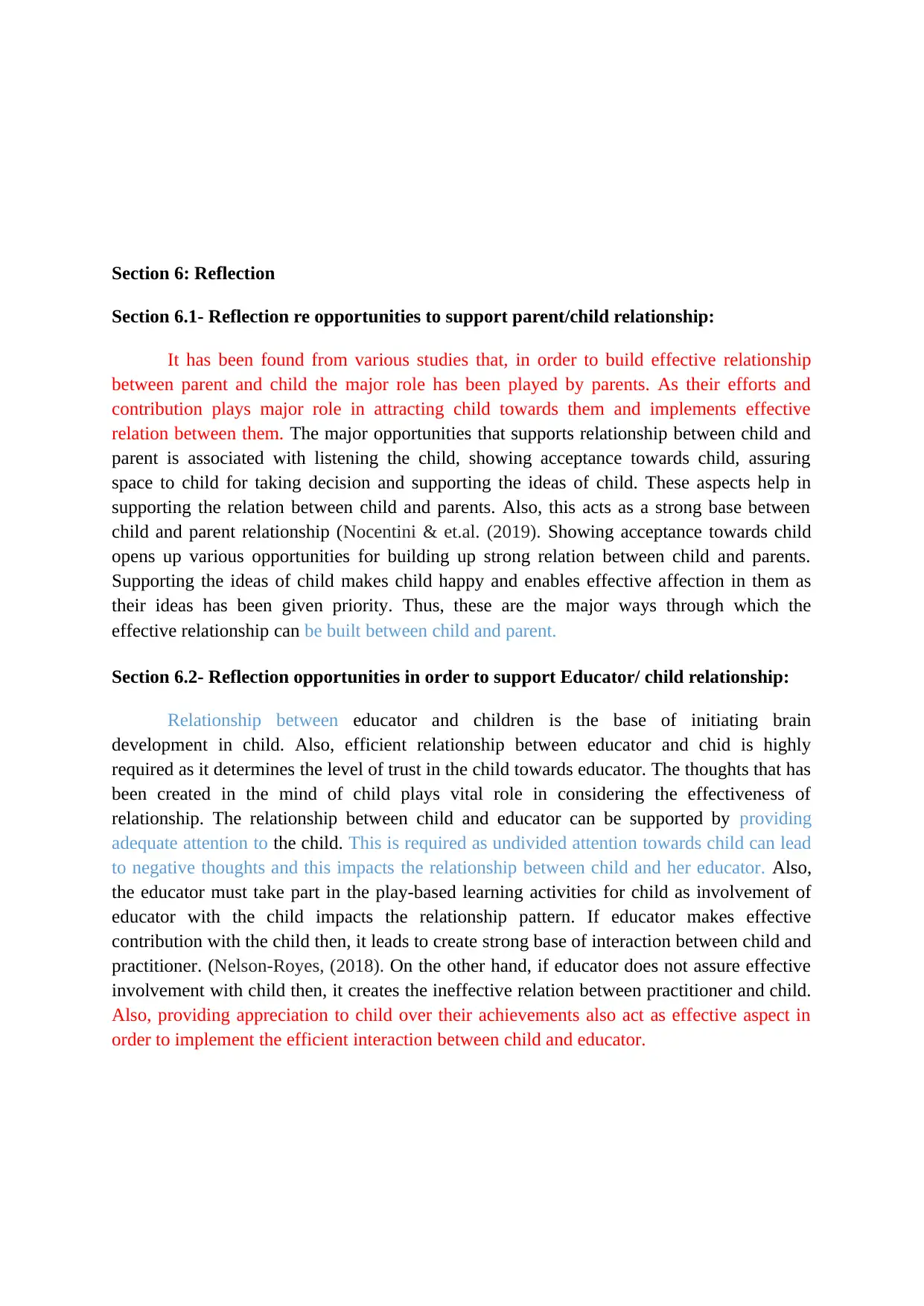
Section 6: Reflection
Section 6.1- Reflection re opportunities to support parent/child relationship:
It has been found from various studies that, in order to build effective relationship
between parent and child the major role has been played by parents. As their efforts and
contribution plays major role in attracting child towards them and implements effective
relation between them. The major opportunities that supports relationship between child and
parent is associated with listening the child, showing acceptance towards child, assuring
space to child for taking decision and supporting the ideas of child. These aspects help in
supporting the relation between child and parents. Also, this acts as a strong base between
child and parent relationship (Nocentini & et.al. (2019). Showing acceptance towards child
opens up various opportunities for building up strong relation between child and parents.
Supporting the ideas of child makes child happy and enables effective affection in them as
their ideas has been given priority. Thus, these are the major ways through which the
effective relationship can be built between child and parent.
Section 6.2- Reflection opportunities in order to support Educator/ child relationship:
Relationship between educator and children is the base of initiating brain
development in child. Also, efficient relationship between educator and chid is highly
required as it determines the level of trust in the child towards educator. The thoughts that has
been created in the mind of child plays vital role in considering the effectiveness of
relationship. The relationship between child and educator can be supported by providing
adequate attention to the child. This is required as undivided attention towards child can lead
to negative thoughts and this impacts the relationship between child and her educator. Also,
the educator must take part in the play-based learning activities for child as involvement of
educator with the child impacts the relationship pattern. If educator makes effective
contribution with the child then, it leads to create strong base of interaction between child and
practitioner. (Nelson-Royes, (2018). On the other hand, if educator does not assure effective
involvement with child then, it creates the ineffective relation between practitioner and child.
Also, providing appreciation to child over their achievements also act as effective aspect in
order to implement the efficient interaction between child and educator.
Section 6.1- Reflection re opportunities to support parent/child relationship:
It has been found from various studies that, in order to build effective relationship
between parent and child the major role has been played by parents. As their efforts and
contribution plays major role in attracting child towards them and implements effective
relation between them. The major opportunities that supports relationship between child and
parent is associated with listening the child, showing acceptance towards child, assuring
space to child for taking decision and supporting the ideas of child. These aspects help in
supporting the relation between child and parents. Also, this acts as a strong base between
child and parent relationship (Nocentini & et.al. (2019). Showing acceptance towards child
opens up various opportunities for building up strong relation between child and parents.
Supporting the ideas of child makes child happy and enables effective affection in them as
their ideas has been given priority. Thus, these are the major ways through which the
effective relationship can be built between child and parent.
Section 6.2- Reflection opportunities in order to support Educator/ child relationship:
Relationship between educator and children is the base of initiating brain
development in child. Also, efficient relationship between educator and chid is highly
required as it determines the level of trust in the child towards educator. The thoughts that has
been created in the mind of child plays vital role in considering the effectiveness of
relationship. The relationship between child and educator can be supported by providing
adequate attention to the child. This is required as undivided attention towards child can lead
to negative thoughts and this impacts the relationship between child and her educator. Also,
the educator must take part in the play-based learning activities for child as involvement of
educator with the child impacts the relationship pattern. If educator makes effective
contribution with the child then, it leads to create strong base of interaction between child and
practitioner. (Nelson-Royes, (2018). On the other hand, if educator does not assure effective
involvement with child then, it creates the ineffective relation between practitioner and child.
Also, providing appreciation to child over their achievements also act as effective aspect in
order to implement the efficient interaction between child and educator.
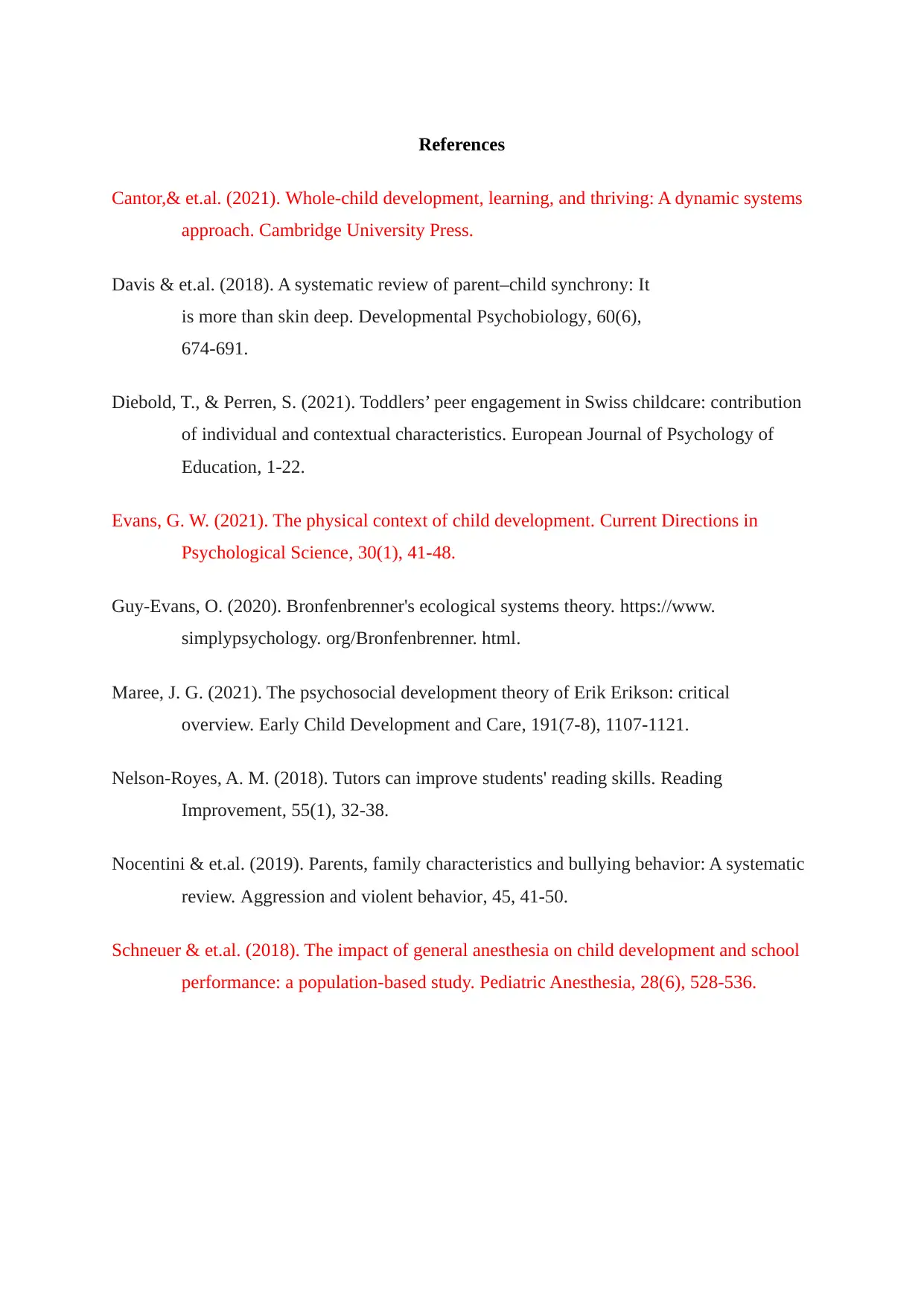
References
Cantor,& et.al. (2021). Whole-child development, learning, and thriving: A dynamic systems
approach. Cambridge University Press.
Davis & et.al. (2018). A systematic review of parent–child synchrony: It
is more than skin deep. Developmental Psychobiology, 60(6),
674-691.
Diebold, T., & Perren, S. (2021). Toddlers’ peer engagement in Swiss childcare: contribution
of individual and contextual characteristics. European Journal of Psychology of
Education, 1-22.
Evans, G. W. (2021). The physical context of child development. Current Directions in
Psychological Science, 30(1), 41-48.
Guy-Evans, O. (2020). Bronfenbrenner's ecological systems theory. https://www.
simplypsychology. org/Bronfenbrenner. html.
Maree, J. G. (2021). The psychosocial development theory of Erik Erikson: critical
overview. Early Child Development and Care, 191(7-8), 1107-1121.
Nelson-Royes, A. M. (2018). Tutors can improve students' reading skills. Reading
Improvement, 55(1), 32-38.
Nocentini & et.al. (2019). Parents, family characteristics and bullying behavior: A systematic
review. Aggression and violent behavior, 45, 41-50.
Schneuer & et.al. (2018). The impact of general anesthesia on child development and school
performance: a population‐based study. Pediatric Anesthesia, 28(6), 528-536.
Cantor,& et.al. (2021). Whole-child development, learning, and thriving: A dynamic systems
approach. Cambridge University Press.
Davis & et.al. (2018). A systematic review of parent–child synchrony: It
is more than skin deep. Developmental Psychobiology, 60(6),
674-691.
Diebold, T., & Perren, S. (2021). Toddlers’ peer engagement in Swiss childcare: contribution
of individual and contextual characteristics. European Journal of Psychology of
Education, 1-22.
Evans, G. W. (2021). The physical context of child development. Current Directions in
Psychological Science, 30(1), 41-48.
Guy-Evans, O. (2020). Bronfenbrenner's ecological systems theory. https://www.
simplypsychology. org/Bronfenbrenner. html.
Maree, J. G. (2021). The psychosocial development theory of Erik Erikson: critical
overview. Early Child Development and Care, 191(7-8), 1107-1121.
Nelson-Royes, A. M. (2018). Tutors can improve students' reading skills. Reading
Improvement, 55(1), 32-38.
Nocentini & et.al. (2019). Parents, family characteristics and bullying behavior: A systematic
review. Aggression and violent behavior, 45, 41-50.
Schneuer & et.al. (2018). The impact of general anesthesia on child development and school
performance: a population‐based study. Pediatric Anesthesia, 28(6), 528-536.
Paraphrase This Document
Need a fresh take? Get an instant paraphrase of this document with our AI Paraphraser

1 out of 8
Related Documents
Your All-in-One AI-Powered Toolkit for Academic Success.
+13062052269
info@desklib.com
Available 24*7 on WhatsApp / Email
![[object Object]](/_next/static/media/star-bottom.7253800d.svg)
Unlock your academic potential
© 2024 | Zucol Services PVT LTD | All rights reserved.




